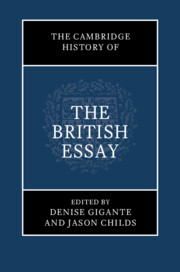Book contents
- The Cambridge History of the British Essay
- The Cambridge History of the British Essay
- Copyright page
- Contents
- Illustrations
- Contributors
- Acknowledgements
- Preface to a History in the Manner of an Essay
- Part I Forming the British Essay
- 1 Ancient Influences on the Essay
- 2 Surprised into Form: The Beginnings of the English Essay
- 3 Miscellanies, Commonplace Books, and the Essay
- 4 Incoherence Brought to Order: Empiricism and the Essay
- 5 The Sermon and the Essay
- 6 Anger, Rhetoric, and Early Women Essayists
- 7 The Polemical Essay in Pamphlets, Newsbooks, and Periodicals
- 8 Between Public and Private: Letters, Diaries, Essays
- 9 The Art of Criticism: Essay as Citation
- Part II The Great Age of the British Essay
- Part III Assaying Culture, Education, Reform
- Part IV Fractured Selves, Fragmented Worlds
- Part V The Essay and the Essayistic Today
- Book part
- Bibliography
- Index
8 - Between Public and Private: Letters, Diaries, Essays
from Part I - Forming the British Essay
Published online by Cambridge University Press: 31 October 2024
- The Cambridge History of the British Essay
- The Cambridge History of the British Essay
- Copyright page
- Contents
- Illustrations
- Contributors
- Acknowledgements
- Preface to a History in the Manner of an Essay
- Part I Forming the British Essay
- 1 Ancient Influences on the Essay
- 2 Surprised into Form: The Beginnings of the English Essay
- 3 Miscellanies, Commonplace Books, and the Essay
- 4 Incoherence Brought to Order: Empiricism and the Essay
- 5 The Sermon and the Essay
- 6 Anger, Rhetoric, and Early Women Essayists
- 7 The Polemical Essay in Pamphlets, Newsbooks, and Periodicals
- 8 Between Public and Private: Letters, Diaries, Essays
- 9 The Art of Criticism: Essay as Citation
- Part II The Great Age of the British Essay
- Part III Assaying Culture, Education, Reform
- Part IV Fractured Selves, Fragmented Worlds
- Part V The Essay and the Essayistic Today
- Book part
- Bibliography
- Index
Summary
Twentieth-century critics have opposed the supposed objectivity of the essay to the letter and diary as private, self-expressive, and autobiographical genres. But this was a modern development. From Michel de Montaigne to the early nineteenth century, the essay, the letter, and the diary were more alike and far more closely aligned than they later became, particularly with regard to representations of the self and notions of publicity. For instance, they were all considered forms of address, and means of presenting one’s intellectual physiognomy to others that were likely to be read aloud, shared, and discussed. This chapter therefore explores now-forgotten family resemblances among these genres both in form and function and concludes by showing where they were fused or embedded in one another.
- Type
- Chapter
- Information
- The Cambridge History of the British Essay , pp. 105 - 119Publisher: Cambridge University PressPrint publication year: 2024

